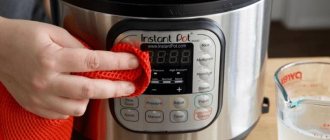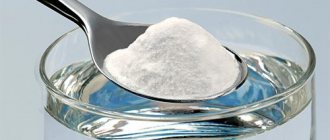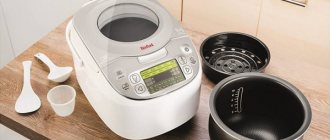If you care about proper nutrition, then a steamer takes pride of place in your kitchen. It doesn’t matter what model you have - the simplest or the most multifunctional - it needs regular cleaning to remove limescale. If you ignore this problem, the service life of the steamer will be shortened, and the quality of the food cooked in it will deteriorate. In this article we have collected the most popular and effective methods of dealing with scale.
How to descale a steamer
Each steamer model consists of both plastic and metal parts.
And all of them need to be cleaned of plaque. There is no need to wait until the layer of deposits reaches several millimeters; it is advisable to carry out cleaning at the first signs of plaque or at intervals of 1-1.5 months.
To clean the plastic parts of the steamer, you need to completely disassemble it and wipe it with soda. The average amount of baking soda is 1 tablespoon per rack. After this, all parts must be thoroughly rinsed and wiped dry.
There are several proven methods for cleaning a steamer, ranging from well-known ones to not quite standard ones. The latter includes cleaning with drinks such as Coca-Cola or Pepsi-Cola.
To use them, just pour the drink into a bowl and boil it for 10-15 minutes. Then leave the liquid inside for 20-30 minutes for better effect.
After the time has passed, thoroughly rinse the steamer with clean water and a washcloth; you can additionally use any detergent.
If there is a thick layer of plaque, the bowl of cola can be pre-soaked overnight.
Let's talk about standard cleaning methods.
Antiscale
A new method of dealing with scale is chemical agents. One of these drugs is antiscale.
To clean the steamer from scale with Anti-Scaling, you need to:
- Depending on the thickness of the scale, pour a small amount (from 100 to 150 ml) of the product into 1 liter of water.
- Place the bowl with the solution in a double boiler on any setting for 10-15 minutes.
- After heating, drain the liquid and clean with a sponge under running water 1-2 times.
- If desired, you can pour clean water into the washed bowl and boil it.
This universal product does not contain phosphates and is not harmful to health or the environment.
Lemon acid
Another way to descale. The advantages of citric acid are the absence of a nasty odor. Also, after using citric acid, you do not need to boil clean water in the device, just wash it.
For this method you need:
- Make a solution of citric acid. Pour 1 liter of water into the steamer bowl and add 1 full tablespoon or 2 dessert spoons of citric acid.
- Set the steamer to cooking mode (20-30 minutes) and wait.
- After finishing work, drain the water and rinse under running water 1-2 times with a soft sponge.
- After complete drying, the steamer is ready for use.
Vinegar
One of the most popular descaling methods is acetic acid washing. This method is even described in the instructions for household appliances. There are 2 ways to clean with vinegar.
Long. If you have time, you can pour vinegar into the container to be cleaned and leave for 3-4 hours. The cleaning process can be seen even visually - bubbles will form. This vinegar reacts with salts and hydrogen is released.
After the time has passed, pour out the vinegar and thoroughly wash off all the plaque with a soft sponge. If scale remains, you will have to repeat the procedure. If the steamer has become clean and shiny, then fill it with fresh water and boil it, this is necessary to remove any remaining acid and remove the unpleasant odor. Then drain the water and dry the bowl thoroughly.
Fast. When you are short on time and need to clean the steamer, you will have to boil vinegar. For this you will need:
- Pour 9% vinegar into the container that we will clean. The liquid should reach about. If desired, the acid can be diluted slightly with water or vinegar concentrate can be used in a ratio of 1 part vinegar to 5 parts water.
- Turn on the steamer in any cooking mode for 20-30 minutes.
- After cleaning, drain the water, rinse the device with a sponge and set clean water to boil.
- If after one boil the smell does not completely go away, the procedure can be repeated.
Use only soft sponges or simple rags.
Our kitchens are replete with household appliances, a refrigerator and a microwave are a must, but we also need other appliances. For example, in order to eat tasty and healthy food, many housewives prefer to cook in a double boiler.
You can steam a variety of foods
This modern device does its job perfectly, but after work it requires care and washing. Today we would like to talk about how to clean a steamer from various contaminants: scale, grease.
How to descale a steamer spiral
The spiral of the double boiler is a different matter. This will require not just cleaning, but heat treatment. The simplest remedy for descaling a kettle is vinegar: just boil a mixture of vinegar and water in a kettle, and the scale will be gone! The same product also helps when cleaning the steamer.
To begin, remove all the grates from the steamer and leave only the base - the lower part of the device, in the center of which the heating coil is located. Pour two glasses of table apple cider vinegar (up to 9%) into this part of the steamer. Check to see if the coil is coated with liquid. If it is not covered, you need to add enough water so that the spiral hides under water.
After this, we put a plastic protective cap on the spiral, and then everything is as with normal steaming of food. Place the grill and cover it with a lid. Plug in the steamer and set the timer for half an hour.
If you are the happy owner of a steamer, then you just need to know how to care for it, namely how to descale the steamer so that it works longer and better.
Why does scale form in a steamer?
Scale in a steamer is formed as a result of using hard water. The more magnesium and calcium in water, the harder it is.
How often should you descale your steamer?
Therefore, how often you should clean your steamer depends on the water used. Many instructions for steam cookers indicate that scale should be removed every 8 cooks, but the frequency can range from 6 to 10 cooks.
Video material
A steamer, like any other household appliance that interacts with water, is susceptible to scale formation. As soon as you notice plaque on the surfaces and heating element, you should immediately take measures to remove it. You should not use abrasives or hard sponges for this. This way you will only harm your device, and you may even damage it irrevocably. It’s better to use one of the methods given in this article. By removing whitish formations in this way, you will extend the life of the device for cooking healthy food for a long time.
Lemon acid
A cheap product that is great for cleaning kettles, washing machines and other household appliances. That's why it's always useful to have it in the house. Take a small packet of citric acid and pour it into the bottom of the steamer. Fill with filtered water - you need enough to last for 20-25 minutes. Install all containers of the steamer and start the device to work. After the specified time, turn it off. The plaque will move away from the walls of the parts and the heating element.
Carefully rinse all parts of the device. Removable parts are washed under running water. The container with the heating element is wiped from the inside with a sponge several times.
Drying
After carrying out the cleaning procedure, all structural parts of the kitchen appliance must be thoroughly dried.
Drying is carried out using one of the following methods:
- in a natural way - spread a large towel on a horizontal surface, place all the parts on it and wait for them to dry;
- manually - arm yourself with a napkin or rag (made of soft, natural fabric) and thoroughly wipe all surfaces of each element of the multicooker;
- A household hair dryer will help speed up the drying process: turn on the device, direct the air flow to the parts. Make sure that the outgoing air is not too hot.
Acceptable methods
The first cleaning recipe will be based on such a popular substance as vinegar. To clean the heating element of the steamer, which looks like a spiral, we need regular 9% vinegar, you can take the apple version.
When descaling, we don’t need separating grates, so we take them out and pour half a liter of vinegar into a container. If the heating element is not completely immersed in the liquid, then add regular water. After this, we put a protective cap on the spiral, close the device with a lid and turn it on to work for 10-15 minutes. Usually this time is enough, but if the scale is deeply ingrained, you can add another 5 minutes.
Classic apple cider vinegar
Vinegar does an excellent job of removing scale, this is a well-known fact, so after the device is in operation, the spiral will look like new. But do not rush to finish washing the steamer; in order to clean its insides from harmful vinegar, you need to wait until it cools down and wash the container thoroughly. After which the device is started with ordinary water for 5-10 minutes of operation for final steam treatment. Steam allows you to thoroughly clean household appliances from traces of vinegar and scale residues. Now the device can be used for cooking.
Various substances can act as a substitute for vinegar; it is permissible to use citric acid. Usually this product is sold in special 25 gram bags. To clean all the insides you will need two of these bags. Citric acid is not as strong and caustic as vinegar, so the treatment time with a composition based on it should be increased by 10-15 minutes, for a total of about half an hour.
Steamed diet food is definitely good for everyone
If you don’t want to clean the device with vinegar or citric acid, then among household products for washing and cleaning equipment, choose a composition called Anti-scale. It is sold in many hardware stores and comes in a liquid state. This product is used in a similar way to clean steamers and other appliances. To create a detergent based on Antiscale, you need to dilute 150 ml of this liquid in 2 liters of water. After treating the elements of the device with household chemicals, be sure to wash it and turn it on at idle with plain water.
If scale has formed in your steamer, it must be removed. In this way, you will significantly extend the life of your steam cooking device, and will not cause any damage to your health, and your food will be tasty and healthy.
A steamer is a wonderful invention that allows you to keep food as healthy and tasty as possible. Unfortunately, due to cooking technology, plaque constantly accumulates on the walls of the appliance and heating elements, which harms both the equipment and the products. How to descale a steamer without damaging the device itself? There are several simple recipes.
The reason for the appearance of scale is known to everyone - bad and hard water.
. Using apple cider vinegar for this procedure is very effective, as it softens the water and disinfects the containers:
- Pour a couple of glasses of vinegar (5%) into a water container and dilute it with water so that the heating element is hidden under it.
- Now we assemble our steamer, close it with a lid and plug it in.
- Set the work timer for about 10-15 minutes and let the vinegar do its job.
- After this, turn off the device and wait until all its elements have cooled completely.
- Wash all parts of the steamer.
Negative effects of limescale on household kitchen appliances:
- White limescale blocks a lot of the heat that comes from the heating element. Subsequently, the cooking process slows down and the service life of the equipment is reduced.
- When harmful salts get into food, they affect the functioning of the kidneys and genitourinary system.
- Household appliances that operate with a timer, such as a multicooker or a double boiler, if there is scale on the heating elements, cannot correctly calculate the cooking time for certain dishes, since a large amount of heat is simply lost.
Based on such negative consequences of the impact of limescale on household appliances, it is very important to take care of them in a timely manner and know how to descale a steamer quickly and effectively.
Important! The steamer should be washed to remove white formation due to the use of hard, untreated water at least after 9-10 cooking cycles.
Further care to prevent lime deposits
Regular care and compliance with the operating rules of the iron will help prevent the appearance of scale:
- It is advisable to pour filtered water into the iron, because the fewer salts contained in the liquid, the longer the device will remain clean;
- at the end of ironing, the water must be drained (this will help avoid the appearance of an unpleasant musty odor and prevent the appearance of scale);
- the device must be kept in an upright position at all times, with its nose up (even when turned off);
- It is necessary to carefully ensure that the sole of the iron remains perfectly flat (it is almost impossible to remove scale from dents or chips).
It is best to monitor the condition of a household appliance from the moment of purchase. Early prevention of scale will preserve the original appearance of the iron for a long time.
Rules for safe operation of a steamer
Once you get used to this new addition to your kitchen, it will take very little time to maintain it. In return, you will receive properly functioning equipment and healthy dishes. To ensure long-term use of the device, be sure to read the steamer’s operating instructions. You can download the instructions for your Miele model here. Enter the name or serial number in the form and click on the “Search” button.
Receive a selection of new articles by email
Source
Why does plaque form?
A clothes steamer is a special device. The electrical appliance allows you to iron various fabric items using a stream of hot steam. Household appliances are used in everyday life and professional institutions.
Typically a steamer includes:
- telescopic stand (with clothes hanger);
- steam supply hose;
- iron;
- steam generator in a plastic case.
The device has various modifications:
- manual;
- floor;
- multifunctional.
The electrical appliance resembles an iron, but is not a complete alternative. It allows you to smooth out products without the use of additional devices, such as a board. Using the device, you can add shine to clothes made from delicate fabrics.
The service life and quality of operation of the steamer depends on compliance with basic requirements. The device must be descaled regularly.
Limescale deposits form in household appliances whose operating mechanism involves heating water. In this case, deposits are released, usually including calcium and magnesium, as well as other impurities. The appearance of plaque on the walls of the device can cause its breakdown and the presence of stains on clothing.
Attention! Cleaning the steamer from scale is a necessary procedure. It should be performed regularly, as indicated in the operating instructions for the device.
Why does scale form on equipment?
Many cooking appliances suffer from the formation of a white coating on their surfaces. The steamer is no exception. The cause of such pollution is poor-quality, hard water, which contains large amounts of calcium, salts and magnesium. In the process of boiling such water, salt and other elements are released from the liquid and form a limescale deposit on the heating device.
Important! The easiest way to detect scale is on a kettle, since this item is used exclusively for boiling and heating water. The same principle applies to the formation of deposits in a steamer.
Cleaning the steamer. How to clean a steamer
Let's talk about how to clean a steamer. Before cleaning the steamer, always unplug it from the electrical outlet! With the exception of the base (base), all parts can be washed in the dishwasher or by hand using commercial household detergents, preferably non-abrasive, so as not to scratch the transparent plastic of the steam baskets, otherwise it will become opaque and scratches will be visible on the surface. The lattice bottom of steam baskets is more convenient to clean with a brush; in some models of steamers, the bottoms are removable, which also makes them easier to wash. The base (the base of the steamer, inside of which there is an electrical heating device) should be wiped with a damp cloth. Do not clean the steamer with abrasive (scratching) sponges or powders.
Cleaning the steamer grates
Modern steamers are made of plastic. It doesn’t matter what brand of steamer you have: the base, grates and lid of the steamer are most likely plastic. And this material is insidious; it darkens and fades from frequent contact with high temperatures. This is especially true for steamer grates, which come into contact with various products.
How to clean steamer grates? It’s very simple - just have a small amount of soda in the house. If you see that the grilles have become dull or “overgrown” with a grayish coating, take soda and thoroughly wipe the plastic with your hand. The calculation is as follows: for one steamer rack – 1 tablespoon of soda. Give the plastic a good scrub with baking soda, then rinse with water and admire the sparkling grates!
Dishwasher Care
- Lemon acid. Pour in this universal product and run the machine for a full cycle. Be sure to repeat the rinsing procedure to thoroughly remove any remaining scale.
- Three lemons. Cut citrus fruits and rub juice on all accessible surfaces of the dishwasher. Suitable for lightly soiled kettles.
- Pour a half-liter bottle of table vinegar into the lower basket, and start the machine in water heating mode. As soon as the cycle reaches the middle, stop it. Let the machine stand like this for 4-5 hours, and then complete the cycle to the end.
- Bleach is a risky but effective cleaning method. Not suitable for stainless steel parts only. Pour 200 ml of bleach into the dishwasher and run the unit on a full cycle and at high temperature.
Acceptable methods
The first cleaning recipe will be based on such a popular substance as vinegar. To clean the heating element of the steamer, which looks like a spiral, we need regular 9% vinegar, you can take the apple version.
When descaling, we don’t need separating grates, so we take them out and pour half a liter of vinegar into a container. If the heating element is not completely immersed in the liquid, then add regular water. After this, we put a protective cap on the spiral, close the device with a lid and turn it on to work for 10-15 minutes. Usually this time is enough, but if the scale is deeply ingrained, you can add another 5 minutes.
Classic apple cider vinegar
Vinegar does an excellent job of removing scale, this is a well-known fact, so after the device is in operation, the spiral will look like new. But do not rush to finish washing the steamer; in order to clean its insides from harmful vinegar, you need to wait until it cools down and wash the container thoroughly. After which the device is started with ordinary water for 5-10 minutes of operation for final steam treatment. Steam allows you to thoroughly clean household appliances from traces of vinegar and scale residues. Now the device can be used for cooking.
Various substances can act as a substitute for vinegar; it is permissible to use citric acid. Usually this product is sold in special 25 gram bags. To clean all the insides you will need two of these bags. Citric acid is not as strong and caustic as vinegar, so the treatment time with a composition based on it should be increased by 10-15 minutes, for a total of about half an hour.
Steamed diet food is definitely good for everyone
If you don’t want to clean the device with vinegar or citric acid, then among household products for washing and cleaning equipment, choose a composition called Anti-scale. It is sold in many hardware stores and comes in a liquid state. This product is used in a similar way to clean steamers and other appliances. To create a detergent based on Antiscale, you need to dilute 150 ml of this liquid in 2 liters of water. After treating the elements of the device with household chemicals, be sure to wash it and turn it on at idle with plain water.
If scale has formed in your steamer, it must be removed. In this way, you will significantly extend the life of your steam cooking device, and will not cause any damage to your health, and your food will be tasty and healthy.
Supporters of a healthy lifestyle know: cooking in a double boiler is very healthy. After all, in this case, the beneficial substances contained in the products are preserved, and the cooking method does not overload the dishes with excess fats and carcinogens. But if you often use a double boiler, it cannot escape contamination: scale forms on the spiral, and the grates simply darken. How to clean a steamer using improvised means? Let's figure it out.
Store funds
There are also special compositions for descaling. The effect of such a remedy is as good as that of traditional recipes. But to use it you must strictly follow the instructions:
- The first thing to do is dilute 75 milliliters of the product with 1 liter of water.
- Now pour the resulting mixture into a double boiler, collect and cover with a cap.
- Turn on the device for 10-15 minutes.
- After the designated time has passed, carefully disassemble the device and rinse it with water.
- Your steamer is ready to use. You can use it!
You can buy this product at any hardware store. Finding it will not be a problem, since the drug has a simple name - “anti-scale”.
Special means
If you do not like to use traditional methods, then you just have to buy a special descaling cleaner in the store. As a rule, it is called “Antiscale” and is produced by different manufacturers of household chemicals. Depending on the brand, its price can vary greatly. Use this product according to the instructions on the package. As a rule, it is filled with water, and then the steamer with the resulting solution is turned on for 10-15 minutes.
Reviews about anti-scale are not so clear. Some find it inconvenient to use, and some even complain about damage to the equipment.
In any case, we recommend that you try citric acid first. This is the simplest, most effective and safest descaler, and also very inexpensive.
Carbonated drinks
Coca-Cola and its analogues are famous for their cleansing properties. Most often they are used to remove limescale from the walls of an electric kettle. However, for a double boiler this method will be no less effective.
Pour soda into the device, then turn on the device for 15 minutes. During this time, the drink should dissolve the scale. If the case is complex, you can first leave the liquid in the double boiler overnight and then carry out the procedure.
Please note that many types of soda contain dyes, which can eat into the plastic. If you are not sure of the quality of your steamer, then choose soda without coloring substances.
How to clean a kettle from grease outside
All of the above recipes work great in the case of fatty deposits. And to increase efficiency, before washing the kettle of grease from the outside, fill it with water and heat it up. The higher the temperature of the metal, the easier it will be to deal with dirt.
In addition, if we are talking about stainless steel cookware, regular activated carbon will help remove grease. But first it should be ground into a fine powder. Otherwise you may scratch the sides. Lightly moisten the powder and apply it to the contaminated area. After half an hour, wipe the surface with a soft sponge (not with an abrasive surface) and rinse with clean water. Old stains can be removed quickly and easily using a soda ash bath. According to reviews, soda ash can clean even a completely burnt metal kettle. Moreover, the more soda there is in the working solution, the faster the fat will dissolve.
Please note: the recipe is only suitable for enameled and cast iron products. In other cases, the use of soda ash will cause irreparable damage to the coating. You can clean the kettle with Coca-Cola, Sprite or Fanta
To do this, simply immerse it completely in soda and leave it for a couple of hours.
General rules for caring for a steamer
Regular cleaning: how to wash a steamer
You need to take care of your steamer after every use, even high-tech ones like those from Miele. It is necessary to clean the working chamber, the door on both sides and its seal. Remove and clean metal guides and food trays - either by hand or in the dishwasher
It is important to collect condensation and remove contaminants. This way, the next time you cook, there will be no foreign odors or soot inside the appliance.
Be sure to remove the water container and empty it every time. To prevent limescale from forming on the walls of the container, wipe it dry. The same applies to the working chamber - let all its elements dry before closing the device. You should also carefully consider the choice of household chemicals and equipment:
- Do not use hard metal sponges, brushes or scrapers.
- Do not wash equipment with soda, bleach, abrasives, alkali or acid.
- A regular dishwashing detergent or specialized ones from Miele - powder, spray or gel - will do.
Cleaning the steamer from scale
Since this type of equipment operates on water, scale formation inside is inevitable. If you do not take care of the steamer and do not monitor the formation of salt deposits, the device will quickly fail. However, such a scenario is practically impossible with models from Miele. There is an indicator inside that lights up when descaling is required. If the user ignores this signal for ten cooking cycles, the steamer will lock and will not operate until the deposits are removed.
To descale the steamer, use special products. You should not resort to traditional methods - you risk ruining the device. Miele has tablets that work great for this problem. Place one in a water container and run the idle cycle twice. Afterwards, the water must be poured out of the container, washed and dried in the working chamber. The steamer will work for a long time until the next cleaning.
Where does limescale come from?
Scale is hard deposits on the walls of a device (vessel) in which water was heated, boiled or evaporated.
A device that has been subjected to the formation of such deposits may become unusable if not properly maintained.
The cause of scale is bad or hard water. Such water contains a large amount of heavy salts, which subsequently form limestone formations when heated.
To reduce the risk of sediment formation, clean the water before boiling - use filters or special products that reduce water hardness.
Almost all new models of steamers are equipped with a special indicator light that lights up when the device needs to be cleaned of deposits.
How to descale a spiral?
It is quite easy to descale with 9% apple cider vinegar and water. So, take out all the grates, leaving only the bottom part. In the very center there is a heating element. Pour vinegar into the reservoir and add water if the vinegar itself does not completely cover the element.
Then assemble the device and turn it on for 10 minutes. As a result, the spiral will become clean and shiny - this is what needed to be achieved. Now rinse the device thoroughly, fill it with clean water and turn it on for another 5 minutes.
No vinegar? No problem. In this case, you should have citric acid diluted in water. If the scale is removed very poorly, you will need more acid. And if when cleaning with vinegar we had to turn on the device for 5 minutes, then when using citric acid, we need to activate the steamer for about 20 minutes.
How to descale a kettle | News, reviews, promotions in the TOP SHOP online store
- To clean the same Bosch coffee machine, turn on the machine, wait until it warms up and rinses itself from the inside.
- From the menu, select Maintenance, Care or Cleaning. Next, stop at Descale, Cale or “Descaling”.
- The machine will do 1-2 cleaning cycles through the feed dispenser, after which it will ask you to add a cleaning product.
- Dosage - as in the previous guide: 150-500 ml of liquid product or 2-3 cleaning tablets for coffee machines. In any case, add water to the 0.5 liter mark on the tank and wait until the product is completely dissolved in the water.
- Place a large container under the faucet of the device, open the steam tap or click on “Start”, “Ok”.
- The equipment will begin to circulate 100-200 ml of cleaning solution through itself, taking breaks of 5-10 minutes - until it is all gone.
- When the machine asks you to add water or empty the tray, remove the water tank, rinse it thoroughly, then fill it with clean water to the maximum value and return it back.
- For complete cleaning, it is necessary to add from one to several tanks of water in this way.
- As soon as the washing is completely completed, the machine will inform you about this with a message on the screen.
That is why housewives try to prevent scale from appearing in the kettle using filters, products and various types of water softening agents.
Recommendations and prevention of scale formation
It is impossible to completely prevent the formation of scale in the steamer; one way or another, with frequent use of the device, it will appear on the walls. But you can slow down its occurrence if you follow simple rules:
- pour filtered or distilled water with a soft composition without hard salts into the household appliance;
- use a magnetic transducer - a special tube for pump-action models that does not allow mineral salts to settle on internal parts.
To prevent plaque from turning into a serious problem, it is recommended to clean the steam steamer preventatively once a month or less, depending on the intensity of use of the device.
Some steamers work with hard water, but they last longer when using filtered water.
Why is it so important to fight scale?
In addition to its unpleasant appearance, scale brings with it a number of other problems:
- Problems with household appliances: a large layer of deposits reduces thermal conductivity and requires high energy consumption. When trying to get rid of a thick layer of limescale, there is a chance of slightly deforming the device.
- Health problems: scale negatively affects the condition of teeth. Also, when systematically consuming food cooked in a container with sediment, the salts released during boiling settle in the body and can cause osteochondrosis or problems with urination.
- Taste problems: scale flakes can fall off during boiling and get into the food, giving it an uncharacteristic taste and unpleasant appearance. Pieces of scale feel like small pebbles when they get on your teeth.
Traditional methods
At home, the steam generator can be cleaned using folk remedies. They will thoroughly clean the device without damaging its parts. The following are popular folk remedies.
Lemon acid
First you need to completely dissolve the citric acid in hot water. To do this, take 1 liter of hot water and 25 g of citric acid. Do the following:
- Dissolved citric acid is poured into the tank and left for 25 minutes.
- The maximum temperature is turned on and the steam generation mode is turned on. It is necessary that the liquid evaporates completely. The procedure is performed several times.
When cleaning, you should iron the unnecessary fabric.
Vinegar
To descale a steam generator using vinegar, you must:
- Vinegar and water are mixed in equal proportions.
- The solution is poured into the device and left for 15 minutes.
- Then the device is set to maximum power and the steam supply is turned on.
- The steam generator is washed with water.
Mineral water
Mineral water is poured into the boiler. The device turns on at maximum power. Constantly ironing unwanted fabric, you need to release steam until the water runs out. The device is then washed.
You can clean the device with mineral water as a preventative measure 2-3 times a month. You can use regular mineral water or highly carbonated table drinks.
Steam bath
Use a steam bath to clean clogged holes on the soleplate of the iron. To work you need to prepare:
- wide metal container;
- metal brushes 2 pcs. Their height should be 1-2 cm;
- planks.
Vinegar and distilled water
For cleaning, you need to prepare 200 ml of vinegar and 1 liter of distilled water. Pour the solution into the boiler and turn on maximum power until complete evaporation. Then take a baking sheet and place the back of the device on a raised platform. Fill the baking tray with the solution to a height of 2 cm.
The baking tray is set to heat up, and the iron is set to maximum power. Bring to a boil. Then you need to let the device cool down. Next, the steam generator is cleaned. If the quality of cleaning is satisfactory, then a test ironing of the unnecessary fabric is carried out.
Dishwashing liquid
The sole of the device is slightly heated and then rubbed with laundry soap. The resulting plaque is removed using a wooden spatula. Instead of soap, you can use dishwashing detergent applied to a sponge.
Do you use folk remedies to descale your appliance?
Not really
Washing technology
Scale builds up in many household appliances used for cooking. It appears as a result of not the highest quality, hard water, which contains large amounts of salt, calcium, and magnesium. Such water is not present in all regions of our country, but if you have hard water, you will have to take more careful care of your household appliances. If there is a possibility, then you can always, there are many ways to do this.
During the boiling process, salt and other elements are released from the water, so scale and limescale deposits form on the heating element. The easiest way, since this device specializes exclusively in boiling water.
Classic three-tier installation
Scale blocks a large amount of heat coming from the heating element, which slows down the cooking process and shortens the life of the appliance by constantly overheating it. In addition, once in food, harmful salts can affect the functioning of the genitourinary system and kidneys. Devices that operate with a timer, such as a double boiler or, if there is scale on the heating elements, are not able to correctly calculate the cooking time, since a large amount of heat is wasted.
Therefore, when working with hard water, it is recommended to wash household appliances used for cooking regularly. It is not so difficult to descale a steamer, so you can carry out these activities after 9-10 cooking cycles, or even more often.
Before washing the steamer after eating, look through the instructions; the main points are indicated there. The fact is that such household appliances are made from different materials that require appropriate care.
After disconnecting the device from the network, you can disassemble it. To clean all its parts except the base, you can use regular dishwashing detergent; it is quite effective with various contaminants. For example, it can cope with greasy deposits on grates. Do not use abrasive powders or hard brushes to avoid scratching the plastic parts, especially the transparent parts. If you don’t want to wash the parts by hand, load them into the dishwasher, it will do an excellent job and help clean our plastic parts from any dirt.
Disassembled and refurbished installation
If the bottom of the steamer is removed, that’s just fine, it will be easy to wash it along with the rest of the parts, but if not, then some difficulties will arise, you will have to wash it together with the base. To do this, use a damp cloth, act carefully and calmly.
If the heating element is covered with scale, you will have to remove it, for which there are a number of effective methods.
Professional help
You can clean the thermopot from scale either using special detergents or using proven methods from the people. In the first case, we are talking about professional tools (take SVOD-TVN as an example). Such preparations are sold in the household chemicals department. What are they good for? The composition of the products includes substances that fight against corrosive manifestations, organic and inorganic acids.
List of advantages:
- gentle removal of plaque without damaging the inner surface;
- health safety.
However, to comply with the last point, the device should be rinsed thoroughly. This diligence is necessary to ensure that chemical residues do not damage the sealing elements.
Recipes
- Pour brine into the kettle. The liquid should completely cover the plaque.
- Boil the brine.
- If the deposit is not strong, you can turn off the oven immediately after the brine boils. If the coating is dense, then you should continue boiling (15 minutes will be enough).
- Wait for the brine to cool.
- Pour the liquid out of the dish.
- Rinse the kettle thoroughly with a sponge.
Citric acid from scale in a kettle can be replaced with lemon. Recommended for plastic cases, as well as for models with open heating elements.
Folk remedies Recipes for masks At home Hair loss in women How to stimulate growth Causes of hair loss Hair loss in men Review of vitamins Helpful tips
Dishwasher cleaning frequency
The limescale deposits that form on the walls of the chamber attract food particles and absorb odors from the decomposition of organic matter. An unpleasant aroma that appears when opening the door clearly indicates that it is time for preventative maintenance.
Another sign is associated with increased energy consumption: the heat transfer of the heating element decreases due to the growing limescale layer, and the water heating time increases. The third landmark is the loss of dishwashing quality: the spray nozzles become overgrown with scale and the jets reduce power. Other factors on which the frequency of cleaning the PMM depends:
- frequency of switching on – daily or once a week;
- dirty pots and plates: grease and burnt food are harder to clean than a tea set or vegetable salad dishes;
- operating temperature in the chamber: the higher it is, the more intense the scale builds up, and when the water is warm, a fatty film builds up;
- composition of washing gels - aggressive components clean surfaces better, but their overdose is dangerous to human health; Eco-friendly solutions do not remove fats well.
Dishwasher manufacturers recommend cleaning the washing chamber once a month. But not all housewives follow the recommendations and wipe the equipment as needed: if the dishes shine after the water procedure, then there is no need to interfere with the operation of the machine.
And vice versa, if whitish stains appear on the plates and glasses, it’s time to do preventive maintenance. In practice, PMM care is carried out once every 1–3 months.
lst 11477
First cleaning
Before using the steamer for the first time, you will need to clean it. This is necessary in order to remove dust and dirt particles. They could have settled on the device during storage and transportation from the warehouse. To care for your equipment, you will need a soft sponge, dishwashing liquid and warm water. In the case of built-in and free-standing Miele steam ovens, the first cleaning proceeds as follows:
- Remove and wash the water container, dry it, and place it back.
- Wash the cooking chamber and all internal accessories.
- If necessary, wipe the door with a damp cloth.
- Leave the steamer open for a short time to dry.
- Set the device to the water hardness in your home.
The last point determines how often you will descale the device. Correct settings will help to significantly extend the life of the steamer.
How and how to clean a steamer from scale using folk remedies
If slight scale appears in the steamer, it is not necessary to immediately resort to chemicals. To begin with, you can use home methods for removing deposits.
How to descale a steamer with citric acid
Citric acid perfectly corrodes hard lime deposits and helps restore cleanliness to the internal elements of the steamer. It is used according to a simple algorithm:
- pour a large spoonful of cleaning powder into a glass of warm water and stir;
- after the grains are completely dissolved, pour the product into the compartment of the household appliance;
- tilt the device over the sink and press the steam button.
Dirty water with limescale residues will drain from the steamer openings into the sink. It is necessary to press the button until the solution inside the unit has completely evaporated. After this, the entire procedure will need to be repeated using plain water. This will flush out any remaining cleaning product from the appliance reservoir.
Citric acid is recommended for cleaning metal steamers
How to clean a steamer with mineral water
Carbonated water works well against small scale deposits on the inner walls of the device. It contains carbon dioxide, which helps dissolve solid contaminants. The cleaning scheme looks like this:
- mineral water is poured into the steamer tank;
- heat the apparatus to maximum temperature;
- place over a basin or sink and release steam;
- Continue pressing the button until the soda completely evaporates from the reservoir.
As in the previous case, in conclusion, another cleaning cycle should be carried out to remove residual contaminants, but this time with plain water.
Mineral water is suitable for safe cleaning of plastic steamers
How to descale a steamer using vinegar
You can effectively descale your clothes steamer using table vinegar. It has a caustic composition and softens lime deposits when heated. You need to use it for cleaning according to the standard algorithm:
- 15 g of acidic product is stirred in 250 ml of warm liquid;
- pour water into the special compartment of the steamer;
- heat to maximum and release steam over the sink;
- Clean the unit with plain water again after all the vinegar solution has evaporated.
The only drawback of an acidic substance is its pungent odor. When cleaning, you will have to open the window; in addition, the unpleasant aroma may linger in the device itself for some time.
Concentrated vinegar essence for cleaning can only be used after dilution with water to 9%
How to clean limescale from a steamer with baking soda
Among household products, baking soda has a good effect on scale. The application of the powder looks like this:
- Stir 5 g of the product in a glass of water until completely dissolved;
- the resulting cleaning composition is poured into a fabric steamer;
- the device is left turned off for 4-5 hours;
- after the period has passed, the solution is drained;
- place clean water or mineral water with gas in the tank;
- heat the liquid and release it in the form of steam several times in a row.
The benefits of soda include its safety. The powder solution does not leave behind an unpleasant odor and does not cause any harm to either plastic or metal devices when cleaning.
Baking soda has a destructive effect on scale even without boiling
Beware, steam: note to the hostess
Modern electric steamers allow you not only to cook food, but also to defrost food, sterilize baby bottles or jars before canning, reheat food and even humidify the air.
However, when using them, it is necessary to take certain precautions to ensure that the cooking process is as safe as possible. These are the rules. Safety rules when using a double boiler
Before using the appliance for the first time, remove paper labels and stickers from the internal surfaces and thoroughly wash all accessories (lid, rice bowl, steam baskets, drip tray) in warm water, rinse and dry. Wipe the inner surface of the water tank with a damp cloth.
Place the steamer on a flat and dry surface, leaving enough free space on the sides and top (about 10-15 cm). During operation, the device produces a lot of hot steam, which can damage objects in the immediate vicinity.
Make sure that the mains voltage matches the operating voltage of the steamer. And if your home has weak power wiring, then do not turn on other electrical appliances while using the device to avoid overloads.
Fill the reservoir to the maximum level. Make sure that the heating element is completely hidden by water during operation. If the water level drops below the critical level, the steamer will automatically turn off.
Use oven mitts to avoid burns
During operation, the surfaces of the steamer become hot. Do not touch them with your hands. When removing the lid or steam basket, use gloves or oven mitts to avoid burns. When lifting the lid, hold it in such a way that you will not be exposed to steam or dripping hot water. Remember that the condensate in the manifold is also hot.
Unplug the device every time after use. Do not immerse the cord, plug or base of the steamer in water or other liquids.
Do not use the steamer if it is damaged, for example if there are cracks in the steam basket or lid. If any electrical faults are detected, the device should be taken to a service center. Repairing it yourself will void your warranty and may also cause injury or short circuit.
Practical recommendations
To reduce cooking time, the water tank can be filled not only with cold, but also with warm or even hot water. Just keep in mind that the cooking time indicated in the instructions is designed for using cold water. And if you fill the container with boiling water, you should subtract a few minutes from this time.
To add water, you must remove the steam baskets after turning off the appliance. However, most models, thanks to the water filling hole, allow you to replenish the water tank without removing the baskets, even when the steamer is running. See if your model has such a hole.
If your steamer is equipped with multiple steam baskets, you can cook several dishes at the same time. Moreover, the dish that cooks faster is placed in the upper basket, and products that require long-term steaming are placed in the lower basket. Fish, meat and other ingredients that produce a lot of moisture should also be placed on the lower level so that the juice from them does not get onto other dishes.
It is advisable to lay the products in one layer and not too tightly, leaving space for normal steam circulation. To achieve the best result, cut them into pieces of the same size. If the recipe requires pieces of different lengths and thicknesses, they need to be laid in layers: large ones on the bottom, small ones on top.
In a steamer you can process not only vegetables or fish, but also cook cereals and prepare desserts - thanks to a special container placed directly in the steam basket.
To ensure that vegetables turn out juicy and do not lose their natural color, they should be cooked for the minimum recommended amount of time and salted only after they are cooked. If you are cooking fish or seafood, they can be seasoned with seasonings such as ginger, onion or lemon juice and then wrapped in foil envelopes before cooking.
Cook several dishes at the same time
To give the food a piquant taste, instead of water, you can pour broth seasoned with spices into the steamer, or simply add spices to the water. However, first you should read the instructions; some models may not be designed for such manipulations. The juice remaining in the collector after cooking food can be used to prepare soups and sauces.
Rules for caring for a steamer
Before cleaning, the steamer must be disconnected from the power supply and wait until it has cooled down. The device is easy to clean, since the food cooked in it does not burn and does not stick to the bottom and walls of the steam baskets. With the exception of the base, all parts can be washed either by hand or in the dishwasher using household detergents. The perforated bottom of the steam baskets can be cleaned either with a brush or a rough sponge. The base should be wiped with a soft damp cloth, without using cleaning agents or abrasives.
After 7-10 cycles of use, depending on the hardness of the water, scale forms on the heating element, which must be removed. To do this, pour two glasses of a 5% acetic acid solution into a water container and bring the water level to the maximum. Then install the condensate tray, empty steam basket and lid. Turn on the steamer for 10 minutes. If after this time the scale is not completely removed, repeat the procedure again. When the limescale has completely disappeared, let the appliance cool and drain the vinegar solution. Rinse the water container: fill it with clean water, then drain it, and so on several times. Rinse the lid, basket and condensate tray in clean running water.
As you can see, there is nothing complicated. The family will not go hungry. Bon appetit!
Source











